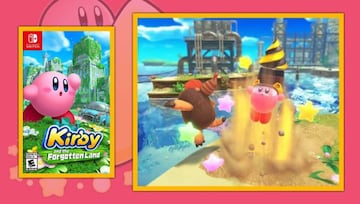Top 10
Top 10 Kirby games
Considering the 30th anniversary of the saga and the arrival of The Forgotten Land on Switch, we chose the best works of HAL Laboratory's mascot.

In late April, the Kirby series turned thirty years old. It's been three whole decades since HAL Laboratory and Nintendo released Kirby's Dream Land in Japan for the Game Boy, the directorial debut of a very young Masahiro Sakurai. Since then, in the increasingly distant 1992, the medium may have changed quite a bit (Sakurai is now a freelancer and has an even more famous fighting saga, I'm sure you're familiar with it), but Kirby has remained a stable constant. A benchmark of the platformer genre that reappears generation after generation, console after console, to satisfy new and old-school fans alike.
By this, we don't mean that the pink ball hasn't evolved along the way. Dream Land, that simple original game, didn't even allow us to copy the enemies' abilities, it simply allowed us to gobble them up and glide by blowing up our protagonist like a balloon. Then came more ambitious proposals, with more mechanics, more variety of situations and now also 3D. Not only to give depth to the scenarios but also to explore them thanks to the recent release of The Forgotten Land on Switch. So considering the occasion, the upcoming release of Kirby's Dream Buffet, and the anniversary, we have paid tribute to the saga and put together a list of the ten best Kirby games.
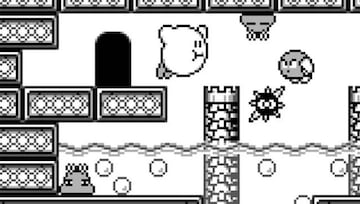
10. Kirby 64: The Crystal Shards
We have just talked about three dimensions and we start, curiously, with the first Kirby with polygonal graphics. Being a Nintendo 64 game, it couldn't have been any other way. The truth is that for all practical purposes it still worked as a side-scrolling installment, but using scenarios with real depth allowed us to take more advantage of the camera, with fluid movements, perspective changes and even rotations around the arenas of some bosses. But what made The Crystal Shards a great Kirby, and an installment still recommended now that three dimensions are the bread and butter, were the combos.
Absorbing and gobbling an enemy served to acquire its ability, but only filled one of the two available slots in the lower bar. Then, if we gobbled a similar one, it served as a power-up; but if we gobbled a different one, the mixture resulted in a new skill. In this way, for example, combining the cutter skill with the fire skill served to wield a flaming sword; combining ice and electricity, transformed Kirby into a refrigerator capable of throwing food and soft drinks; and combining needle with stone resulted in a drill that dragged us around the stage until we let it go. Thus, there were more than thirty possible techniques.

9. Kirby’s Epic Yarn
This Wii installment is somewhat atypical in the sense that it was not developed by HAL Laboratory, but by Good-Feel. The studio responsible for the last Yoshi had the opportunity to reinvent the saga in its own way and did so by taking us to a world where everything, characters and environments, was made up of threads, fabrics and other sewing materials. This change was applied to Kirby himself, who could no longer gobble up his rivals, but rather unravel them with a whip.
Although the saga is far from being characterized by its high difficulty -quite the opposite-, Epic Yarn made the striking decision to eliminate the possibility of defeat. It didn't matter if we were overtaken by enemies, or even if we fell off cliffs, the game would take a few gems and allow us to move on. Finding everything, however, still required a bit more effort, and the game remained interesting level after level thanks to its enormous creativity with the aesthetics and transformations of the wool Kirby, able to become a car, a submarine, a fire truck, a train or a rocket among other forms.
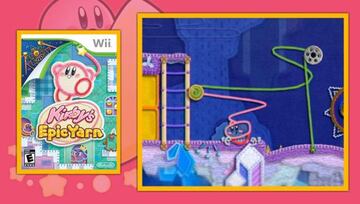
8. Kirby & The Amazing Mirror
Also a bit atypical, although for different reasons than Epic Yarn. This Game Boy Advance release, developed in collaboration with Flagship (the studio behind the handheld's Zelda, Four Swords and The Minish Cap), abandoned linear platforming in favor of a much more open structure, with maps made up of elaborate networks of stages that could be traversed and completed in different orders.
Another interesting feature, and expected given Flagship's experience with Four Swords, was its multiplayer: for the first time in the series, up to four players could cooperate and progress through the adventure together instead of simply battling each other in the mini-games. Of course, doing so required four GBAs and the Link cable, but in return, it offered a level of autonomy not possible in subsequent multiplayer games, as each player had their own screen and could explore in different directions, then use a cell phone to contact and reconvene if they wanted to collaborate or face the bosses as a team.
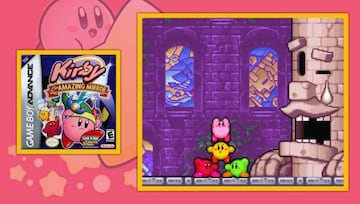
7. Kirby’s Dream Land 2
We are still in the portable arena, but we go back in time, back to the Game Boy. Although Dream Land was followed by a desktop release that will also appear soon, HAL did not leave aside the original console and developed for it another sequel that combined some of the abilities just shown in the NES with new animal companions that we could rescue and ride through the levels: Rick, a hamster that provided extra speed on the ground; Coo, an owl that did the same in the air; and Kine, a fish that naturally improved mobility underwater.
Using these animals did not prevent us from continuing to gobble up and copy the enemies' abilities; on the contrary, in addition to increasing mobility in their respective terrains -although they reduced it in others-, they also functioned as power-ups, increasing the damage or range of attacks to triple their number for practical purposes. Like its portable predecessor, Dream Land 2 is simple by today's standards, but the increase in abilities, levels and enemies, as well as the versatility of the animals themselves, ratify it as a superior installment and one of the best games the Game Boy gave us during the entire nineties.
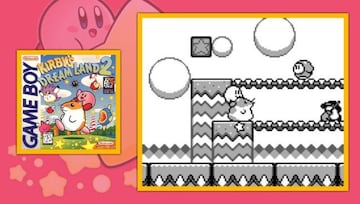
6. Kirby’s Adventure / Nightmare in Dream Land
Dream Land may have marked the official beginning of the saga, but Kirby's Adventure is a game just as transcendental for inaugurating the ability to copy on which virtually all subsequent installments would be based. And it did not do it in a simple way, no: despite its pioneer status, this second installment already implemented more than twenty at once (electric shocks, accelerations, hammers, blades, tornadoes, etc.), establishing a gameplay nearly as varied and flexible as it is today. On the other hand, it also lasted much longer than Dream Land, offering more levels and introducing mini-games on the screens that allowed us to choose a stage or even go back instead of simply advancing in a sequence.
That's why Nightmare in Dream Land, its Game Boy Advance remake, didn't need major changes to reaffirm itself as one of the best installments of the series when it arrived several years later. Coming out after the SNES's Kirby Super Star (which we'll talk about in a moment), the studio took the opportunity to add the cute hats that went along with each of the abilities. Otherwise, it was the usual Kirby's Adventure, but with more detailed graphics and an extra mode to play with Meta Knight -in time trial mode without being able to save between stages.
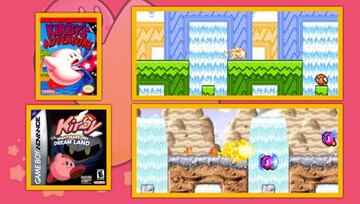
5. Kirby: Triple Deluxe
We moved two portables forward to land directly on Nintendo 3DS, a console where the saga lived a second youth thanks to the detailed three-dimensional worlds that would not have been possible on Nintendo DS; the feeling of depth provided by the stereoscopic effect and a frequent jump between planes (to the screen or to the background). All of this served as a technical demonstration of the machine, but also spiced up the "made in Kirby" gameplay with new platforming challenges, such as looking for switches or keys in one plane that unlocked obstacles in another or avoiding enemies that moved between the two.
The repertoire was also expanded, not only by introducing some copy abilities such as a beetle horn for ramming or a circus hat with which to perform acrobatics, but also by introducing evasion techniques with the triggers -similar to those of Super Smash Bros.- and the hypernova Copy Ability, a super absorption that allowed swallowing enemies much larger than Kirby or even some parts of the scenarios. Despite not reinventing the wheel, Triple Deluxe offered one of the best adventures of the saga and then also allowed to be replayed with King Dedede.

4. Kirby’s Super Star / Super Star Ultra
At the gates of the podium, we find Super Star for Super Nintendo and its remake for Nintendo DS. As previously mentioned, this release was responsible for introducing the hats of each skill that would later be implemented in later games -in addition to more varied repertoires when equipping them-, although another peculiarity is that it was focused more as a compilation than as a traditional platforming adventure. The normal levels were still there, of course, offering both a concentrated reimagining of the first Dream Land and many other new ones, though they were now spread across different modes.
Super Star Ultra, on the other hand, improved and improved its starting point even more compared to Nightmare in Dream Land, by adding even more modes and mini-games to the compilation. In addition to the aforementioned platforming levels, this eclectic title offered races as well as gunfighting duels, card games or combat arenas, and within the platforming also posed more specific conditions such as playing without getting copy abilities by gobbling up enemies (but finding them in specific places) or completing a large interconnected non-linear level in one go. An all-in-one that encapsulated the wealth of ideas that Kirby provided and then went even a little further.
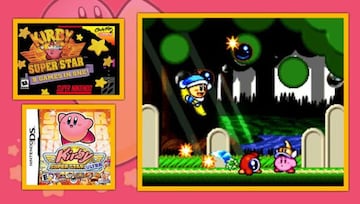
3. Kirby's Return to Dream Land
We return one last time to the desktop to deal with a case opposite to Super Star Ultra, the quintessential Kirby when it comes to the classic platform adventure. Like Triple Deluxe, Return to Dream Land was perhaps not the most innovative, but it did everything as well or better than any of the previous installments, took full advantage of the console's capacity, and allowed playing together with three friends.
The four-player multiplayer, of course, was not a novelty as such, but Return to Dream Land was not limited to the colorful Kirbys of Amazing Mirror (although they were also still an option) and offered differentiated characters such as King Dedede, Meta Knight and Waddle Dee. On the other hand, the predefined repertoires of these companions did not prevent that there were still more than twenty abilities to copy, and even the super abilities, more powerful variants granted by special enemies that could only be used temporarily, were released for the first time. Again, it wasn't a groundbreaking release, but it was excellent when it came to design and playability flexibility.
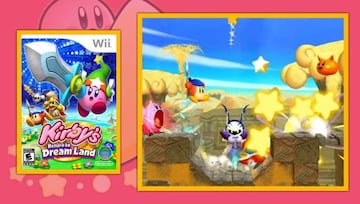
2. Kirby: Planet Robobot
As the second installment of 3DS, Planet Robobot was created from the graphical and playable base of Triple Deluxe (including jumps between different planes), but revolutionized its approach in a more substantial way thanks to the introduction of a robotic armor that we could pilot and improve to get extra abilities beyond the traditional absorption copies -of course, still present-. A mechanic that was not just anecdotal and conditioned the levels much more than the super abilities of Return to Dream Land or the hypernova ability of Triple Deluxe.
Like the animals in Dream Land 2, the armor altered mobility and enhanced the other techniques (transforming into a fast-wheeled vehicle, pulling out a flamethrower, etc.), it could be customized with stickers and found other contextual uses by interacting with the scenery and solving small puzzles. Despite being one of the most recent releases, Planet Robobot was also one of the most creative. It was a constant flow of new ideas and themes successfully applied to the classic formula and the best proof that Kirby still had room to evolve decades after his birth.
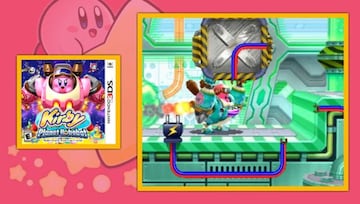
1. Kirby and The Forgotten Land
And this brings us to number one. A game that is 100% Kirby while offering a fresh experience. That combines three decades of experience with inventions that no one had imagined until someone at HAL said "what if Kirby could turn into a car?" In addition to free movement, a couple of new abilities and permanent upgrades to the armory, The Forgotten Land premiered Mouthful Mode, a technique that allows you to cover and control objects as motley as a vending machine that launches its sodas, a giant ladder, a construction site cone.... Not to mention the car itself or the possibility of completely filling Kirby's body with water.
The Forgotten Land recalls the efficiency of Super Mario 3D World, but shows a mechanical variety more typical of Mario Odyssey and the result is phenomenal from the start. Levels are more detailed than ever, feature fresh settings thanks to the colorful post-apocalypse and come loaded with optional challenges. Control not only doesn't suffer from the transition, but it's also exemplary and introduces the ability to roll and dodge enemies in true Bayonetta style, something that leverages the selection of bosses to take the saga to the next level. It's what the first fully 3D Kirby was meant to be and more. The beginning of an era and, in our opinion, the best of the saga.
